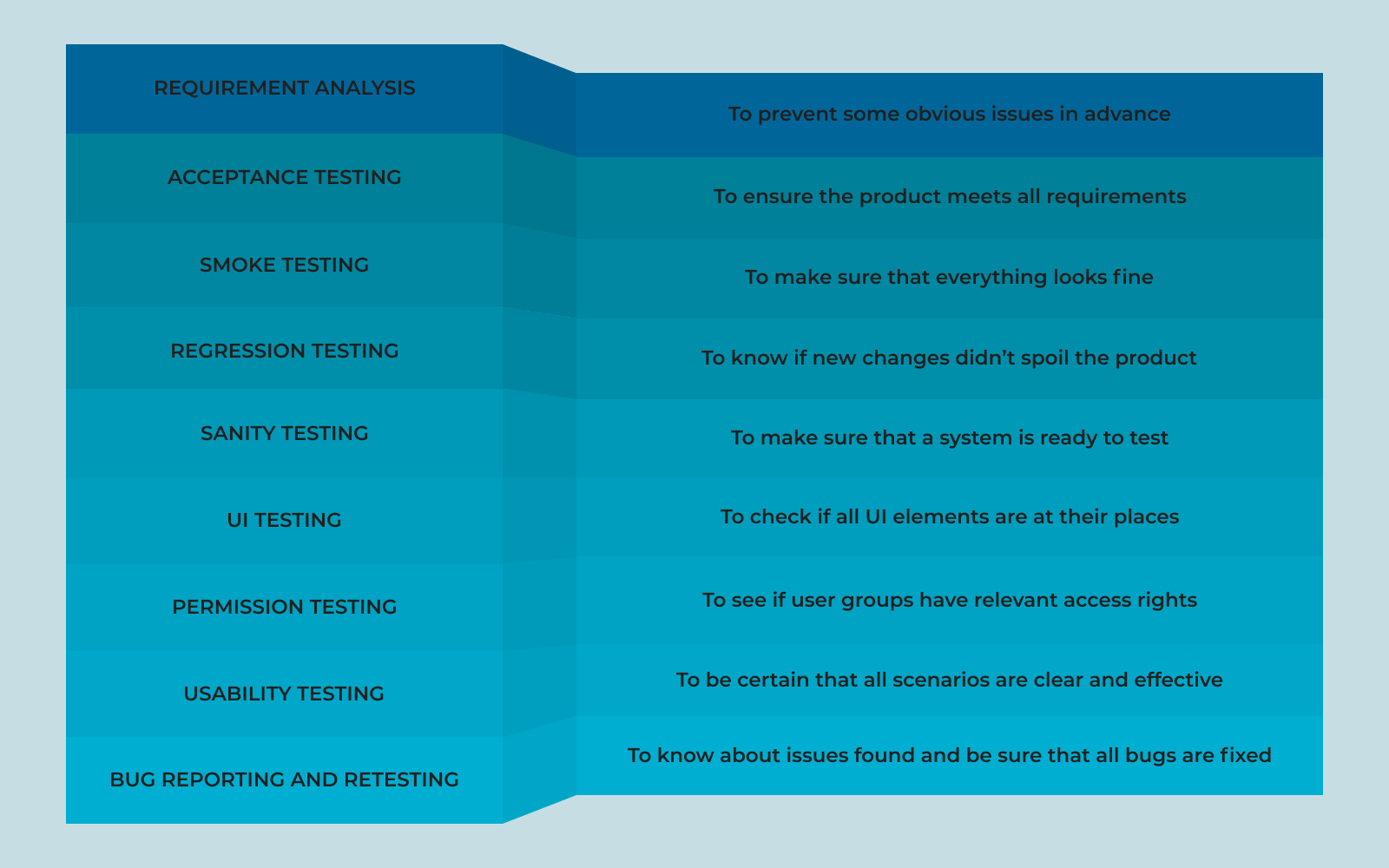Unstoppable technical progress makes any software product more and more complex and there is no escape from it. We will not repeat for the thousandth time the importance of QA specialists in the development process, because everyone already knows this. QA services make an exorbitant contribution to honing and polishing the released software product. However, what specific services are included in this general concept? In this article, we will analyse software testing types in detail. Without further ado, let’s get started.
What Software Testing Types Exist?
Let’s start with the fact that when you order an application development from a company, QA services are always included in the overall package of all services. However, the list of specific types of testing and services may vary from project to project. In total, there are 9 types of services that are worth talking about separately:
- Requirement analysis. The first time where you will meet QA specialists is at the stage of defining project requirements, features, and much more. QA engineers check all the features for consistency, correct functioning and also helps to more correctly determine the time that will be required for the development.
- Acceptance testing. Development is divided into sprints, and at the end of each sprint, the QA team checks the developed part of the functionality for correct operation. In this process, they use User Stories to make sure the features work as intended.
- Smoke testing. This type of testing is performed when the build of the future application is assembled and the QA team needs to check that all its important functions are working and the application starts without problems.
- Regression testing. uring the development process, code can undergo changes countless times. This is due to the addition of features, bug fixes and more. Every time the QA code changes, engineers must check the functionality of the existing features.
- Sanity testing. This is a faster version of regression testing and is also aimed at ensuring that existing features work correctly when the product changes.
- UI testing. This type of testing helps to make sure that the created app layouts are fully consistent with the developed product and the design elements look and work as intended.
- Permission testing. Permissions testing helps to ensure that all users have the correct access rights to a particular functionality. For example, regular users should not have access to the admin panel. This condition is verified by permission testing.
- Usability testing. This type of testing helps create a more favorable user experience by removing rough edges in many aspects that end users of the application may encounter.
- Bug reporting and retesting. In short, every bug and malfunction found is recorded in a bug report, which is then sent to the developers so that they can understand the cause of the bug and fix it.

Reasons Why Basic Testing Sometimes Is Not Enough
Even though all of the above types of testing are aimed at releasing a bug-free product, sometimes they may not be enough. This often happens on extremely rare occasions and when working on very complex projects. In such situations, advanced testing comes to the rescue. However, how do you know when to use it? We have two answers for you:
-
- Advanced testing is necessary if you do not intend to spend additional funds on frequent updates due to minor bugs. In this case, it is better to pay once and a little more, and after thorough testing, update only in order to add new functionality.
- Advanced testing is necessary if a pleasant user experience is everything for you. Otherwise, users who have encountered app problems may never launch your app after that.
What Does Advanced Testing Package Include?
As you may have already understood, Advanced QA services include the following types of testing and operations:
- Sprint 0. This sprint involves the QA team at the stage of studying specifications and wireframes. This helps to eliminate some bugs, unfinished requirements and thus reduce development costs.
- Test automation. This type of testing allows you to significantly speed up Functional and Regression testing since test automation ROI is much higher than regular testing.
- Automated testing for REST API. This type of testing checks the business logic that happens on the server-side.
- Compatibility testing. This test verifies the compatibility of the product with a variety of devices and operating systems.
- Interrupt testing. This testing can be included in the base package, and it includes testing features such as incoming/outgoing calls, push notifications of third-party applications, and many others.
- Load testing. This testing helps to check the server response time.
- Stress testing. At this stage, the performance of the application or server under high loads is checked.
- Security testing. This testing helps to ensure that the application is completely protected from hacker attacks and vulnerabilities.

Wrapping Up
As you can see, there are a lot of software testing types, and all of them are aimed at ensuring the maximum quality of the released software product. Now you fully understand the importance of QA services in the development process and the fact that you always have a choice whether to use only the basic package or connect advanced testing to better polish your application.
